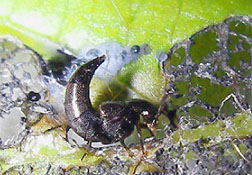This page has been archived and is being provided for reference purposes only. The page is no longer being updated, and therefore, links on the page may be invalid.
|
|
|
|
July 13, 2010
A new beetle that could be used to control the invasive weed skunk vine has been identified by Agricultural Research Service (ARS) scientists and cooperators.
The insect, named Himalusa thailandensis, was found in Thailand by entomologists Bob Pemberton (now retired), with the ARS Invasive Plants Research Laboratory (IPRL) in Ft. Lauderdale, Fla.; Tony Wright, with the ARS Australian Biological Control Laboratory (ABCL) in Brisbane, Australia; and Amporn Winotai, a cooperator with the Thailand Department of Agriculture.
Subsequent study by research leader Ted Center and entomologist Paul Pratt, both with IPRL, and Canadian and Italian cooperators showed this is the first record of the genus Himalusa for Thailand. The insect is only the second described Himalusa species so far; the first Himalusa insect was found in a region of the Himalayas in Nepal.
The tiny, black beetle only measures one-tenth of an inch long, but it packs a punch. It was found feeding on a species of skunk vine closely related to two skunk vine species invading the southern United States. Himalusa species belong to a group of insects that are normally scavengers or predators, so finding a plant-feeding species is a unique discovery.
The adult beetles feed near the leaf mid-vein of the skunk vine plant, gnawing holes the size of their bodies. They also scrape nearby leaf tissues from this refuge, which blacken and decay, producing significant levels of foliar damage. The larvae burrow into and feed within the leaf stalks. As they grow, the stalks swell until they split and the larvae drop out to pupate in the soil.
Center and his team are currently defining the insect's host range and further studying its biology. Preliminary results show that the beetle is specific to skunk vines. There are no native species of skunk vine in the United States, so H. thailandensis could be a promising biocontrol for this invasive weed.
A full scientific description of H. thailandensis can be found in the scientific journal ZooKeys.
ARS is the principal intramural scientific research agency of the U.S. Department of Agriculture (USDA).

